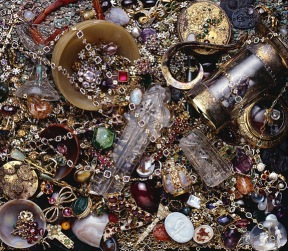16th and 17th Century jewels unearthed 101 years ago by demolition workers goes on display in London.
 Back in June of 1912, London demolition workers were breaking down the dilapidated Wakefield House in Cheapside when they discovered a decayed wooden box beneath the brick cellar floor. Stacked within the box were trays of jewellery and gemstones, a priceless cache of 500 pieces.
Back in June of 1912, London demolition workers were breaking down the dilapidated Wakefield House in Cheapside when they discovered a decayed wooden box beneath the brick cellar floor. Stacked within the box were trays of jewellery and gemstones, a priceless cache of 500 pieces.
The jewellery, which had been hidden and forgotten for more than 250 years, now represents the world’s largest known discovery of Elizabethan and Jacobean-period jewellery.
Dubbed the Cheapside Hoard, the collection will be on display at the Museum of London from October 11 until April 27, 2014. It’s the first time all 500 items have been on exhibit in more than 100 years.
Among the items on display are rings, necklaces, jewelled scent bottles and fan holders, brooches and bracelets. Reflecting how London was a hub of international trade, there are emeralds from Colombia and Brazil; Brazilian amazonite; spinel, iolites and chrysoberyl from Sri Lanka; Indian rubies and diamonds; Persian turquoise; lapis lazuli from Afghanistan; Red Sea peridot, opals, garnets; amethysts from Bohemia and Hungary; and pearls from Bahrain.
Read the full story here.





